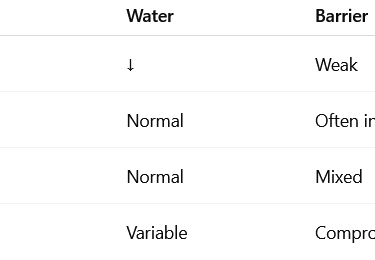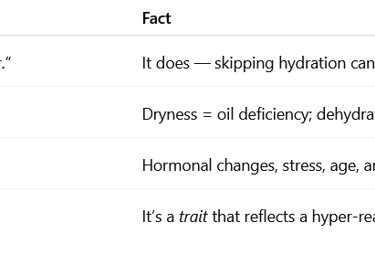
The Science of Skin Types
Note: The content provided by Cordeo is for informational and educational purposes only and does not constitute medical advice, diagnosis or treatment. Always consult a qualified health provider for advice regarding your specific medical condition. [See Full Disclaimer]
Did you know your skin is not just the body's largest organ but also a complex, dynamic system that reflects your health, environment, and genetics? Whether you're in the sun-soaked streets of Los Angeles, the humid climates of Southeast Asia, or the dry air of the Middle East, your skin's needs vary. Understanding its biology and how it differs across individuals and regions is crucial for effective skincare.
Every two to four weeks, your skin completely renews itself — that’s about 500 million cells replaced every single day (1). But have you ever wondered why your friend’s skin glows effortlessly while yours flakes, shines, or reddens?
The answer lies beneath the surface — in your skin’s anatomy and biology. Understanding your skin type isn’t vanity; it’s physiology.
At Cordeo, we bridge the gap between science and self-care — helping you know your skin so deeply that every product, treatment, and habit you choose works with your biology, not against it.
Skin Anatomy 101 — The Science Under Your Mirror
The skin is the body’s largest organ, averaging 16% of total body weight and covering up to two square meters (2).
It consists of three main layers:
Epidermis – your outer barrier, made of keratinocytes, melanocytes, and immune cells (Langerhans cells).
Dermis – the middle layer, rich in collagen, elastin, sweat glands, and capillaries that give the skin strength and elasticity (3).
Hypodermis (Subcutaneous Layer) – a cushioning fat layer that insulates and anchors skin to muscles and bone. (3)
The stratum corneum, the uppermost part of the epidermis, is your skin’s gatekeeper — a “brick and mortar” wall of cells and lipids that prevents dehydration and blocks pathogens (4).
Key Insight:
Your skin type is determined not just by oiliness or dryness but by how your epidermis forms lipids, how active your sebaceous glands are, and how your barrier retains moisture — all rooted in genetics, hormones, and environment (5).
The Five Core Skin Types — More Than Just a Label
Dermatologists generally classify skin into five main types:
Normal Skin – Balanced oil and hydration, even texture, minimal blemishes.
Dry Skin – Lacks natural oils and lipids, feels tight, flaky, or rough to touch.
Oily Skin – Excess sebum, shiny appearance, enlarged pores, acne-prone.
Combination Skin – Oily T-zone (forehead, nose, chin) with drier cheeks.
Sensitive Skin – Easily irritated, prone to redness or stinging; can overlap with any other type (5, 6).
Additionally, the Fitzpatrick Scale classifies skin based on its reaction to UV light, ranging from Type I (very fair) to Type VI (very dark). This classification helps in understanding the risk of sun damage and tailoring skincare accordingly.
How They Differ Biologically:
Sebum production: Oily skin has hyperactive sebaceous glands; dry skin produces less lipid film (7).
Barrier lipids: Ceramides and fatty acids differ between skin types, influencing moisture retention (8).
pH balance: Sensitive skin tends to have a higher, less acidic pH, making it more reactive (9).
Microbiome composition: The bacteria living on your skin differ across types and can impact inflammation and acne risk (10).
Fun fact: Skin type isn’t fixed. Hormones, climate, diet, and even air pollution can shift your skin type over time — that’s why “what worked before” may suddenly stop working.


Evidence-Based Care for Each Skin Type
Normal Skin
Maintain balance with gentle cleansers and light moisturizers.
Use SPF 30+ daily to preserve your barrier and collagen.
Add antioxidants (Vitamin C, niacinamide) for long-term radiance.
Dry Skin
Choose creamy, pH-balanced cleansers.
Apply emollients with ceramides, cholesterol, and hyaluronic acid (8).
Limit long hot showers — they strip essential lipids.
Oily Skin
Opt for gel-based, non-comedogenic moisturizers.
Use salicylic acid or niacinamide to regulate sebum (11).
Blotting papers and lightweight sunscreens prevent pore congestion.
Combination Skin
Multi-zone care: gel products for the T-zone, richer creams for cheeks.
Incorporate balancing ingredients like niacinamide or green tea extract.
Sensitive Skin
Simplify your routine — fewer actives, more hydration.
Look for fragrance-free and hypoallergenic formulas.
Rebuild your barrier using ceramide-rich moisturizers and panthenol (12).
Myths vs. Facts


The Takeaway
Knowing your skin type isn’t about labels — it’s about learning your skin’s language.
When you respect your biology, you unlock a path to healthier, calmer, and more radiant skin.
At Cordeo, we believe skincare should be scientific yet sensorial, where every routine reflects both knowledge and nourishment.
Dermatologist-Approved Product Recommendations
(All globally available and research-backed)
For Normal Skin:
1. CeraVe Hydrating Facial Cleanser – balances oil & moisture (USA/EU).
2. La Roche-Posay Toleriane Sensitive Fluide – minimalist hydration.
For Dry Skin:
3. Eucerin Advanced Repair Cream – rich in ceramides & urea.
4. The Ordinary Hyaluronic Acid 2% + B5 – deep hydration.
5. Avene Trixera Nutrition Balm – replenishes lipids and reduces tightness.
For Oily Skin:
6. La Roche-Posay Effaclar Mat – regulates sebum and reduces shine.
7. Paula’s Choice Skin Perfecting 2% BHA – unclogs pores, minimizes acne.
8. COSRX Oil-Free Ultra-Moisturizing Lotion – with birch sap for hydration.
For Combination Skin:
9. Clinique Dramatically Different Gel+ – lightweight yet hydrating.
10. Bioderma Sébium Hydra – balances oil and moisture levels.
For Sensitive Skin:
11. Avene Skin Recovery Cream – sterile formulation, minimal ingredients.
12. Vanicream Moisturizing Lotion – free from dyes, fragrance, parabens.
Universal Essentials:
13. Neutrogena Hydro Boost Water Gel – universally loved for hydration.
14. EltaMD UV Clear Broad-Spectrum SPF 46 – lightweight daily sunscreen.
15. The Ordinary Niacinamide 10% + Zinc 1% – helps balance oil and redness.
Always patch test new products for 24 hours. If irritation persists, consult a board-certified dermatologist.
REFERENCES
Proksch E., et al. “The skin: an indispensable barrier.” Experimental Dermatology, 2020.
Yousef H., et al. “Anatomy, Skin (Integument).” StatPearls, 2024.
Krishnamurthy K., et al. “Histology, Skin.” StatPearls, 2023.
Elias P.M. “Stratum Corneum Defensive Functions.” Journal of Investigative Dermatology, 2012.
Loden M., et al. “Classification of skin types.” Dermatologic Therapy, 2017.
WHO. “Healthy skin and the role of skincare.” World Health Organization, 2023.
Zouboulis C.C. “Sebaceous gland function and its regulation.” Dermatoendocrinology, 2019.
Madison K.C. “Barrier function of the skin: ‘brick and mortar’ concept.” Journal of Investigative Dermatology, 2003.
Lambers H. “Natural skin surface pH.” International Journal of Cosmetic Science, 2006.
Sanford J.A., et al. “The Human Skin Microbiome.” Nature Reviews Microbiology, 2016.
Dreno B., et al. “Salicylic acid and acne treatment efficacy.” Journal of Dermatological Science, 2018.
Proksch E. “Barrier repair with ceramides and panthenol.” Clinical, Cosmetic and Investigational Dermatology, 2021.
CORDEO
FOR CONATCT:
© 2025. All rights reserved.
Rooted in science. Built with integrity. Designed to empower.
HOME
ABOUT
THE HEALTH EDIT
SKIN BY CORDEO
NOURISH BY CORDEO
MED JOURNAL
CORDEO SHOP
THE HEALTH ORBIT
CORDEO LETTER
THE DIGITAL HUB
CORDEO CONSULTS
CONTACT US
COMING SOON
Cordeo is a digital wellness platform that offers medically-informed content and curated tools for holistic health. The content on this site is for informational and educational purposes only and does not constitute professional medical advice, diagnosis, or treatment. Always consult a qualified healthcare provider for personalized medical guidance.
By using this website, you acknowledge and agree to our Disclaimer, Privacy Policy, Terms & Conditions, Cookie Policy, Editorial Policy, and User Conduct Agreement.
Affiliate & Sponsorship Notice: Some content may include affiliate links, and we may earn a commission on qualifying purchases — at no extra cost to you. We do not process refunds for affiliate partner products or services.
For comprehensive legal and compliance information, please visit our legal and policy center.
This site is governed by the applicable laws of India.
© 2025 Cordeo. All rights reserved. | This site is for informational and educational purposes only and does not constitute professional medical advice.
📢 Cookie & Data Use Notice
We use cookies and similar technologies to enhance your browsing experience, analyze site traffic, and personalize content. By continuing to use this site, you agree to our use of cookies in accordance with our Cookie Policy.
You can manage your preferences or opt-out of non-essential cookies anytime.